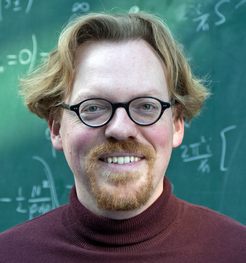What came before the Big Bang?
AEI scientist gives talk at the Falling Walls Conference in Berlin
Please note: Dr. Jean-Luc Lehners will hold his 15-minute talk “Breaking the Wall of the Beginning of Time. How Cosmology Will Tell Us What Happened Before the Big Bang” during the first part of the conference from 9:10 – 10:30 a.m.
The Falling Walls Conference in Berlin, which was held for the first time in 2009 to mark the 20th anniversary of the fall of the Wall, provides a unique look at current research approaches. “I am very curious about the contributions by colleagues from other research fields,” says Lehners. “Nowhere else is it possible to be treated to such a broad overview in such as a short period of time!”
Thinking beyond the boundaries of knowledge
Even though the Big Bang itself is not completely understood, scientists like Jean-Luc Lehners, who heads the String Cosmology Research Group at the AEI, are already developing models to explain how the world might have looked before the Big Bang. “I am looking into questions like ‘Is the Big Bang actually the start of everything?’, ‘Is our universe unique and what does the future look like?’, ‘Is the universe infinitely expanding or will it one day again implode?’” says Lehners about his research area. Investigations into cosmic background radiation are becoming increasingly precise, i.e. the scientists, through the tiny temperature fluctuations that are measured by ESA’s Planck satellite, have increasingly better insight into the nursery of the universe. “But what took place prior to this? In my research group we develop mathematical-physical models in an attempt to understand what was happening before the Big Bang,” Lehners explains.
Models for the “temperature curve” of the universe

The temperature fluctuations in the cosmic background radiation which occurred during the Big Bang can provide information about the birth of the cosmos. Models in the area of string cosmology, a young research area on the border between particle physics and cosmology, are intended to make projections about specific patterns in this temperature data. With these patterns, astronomers can then conduct targeted searches in their data - which in turn is a benchmark for the theories.
The Big Bang is still considered to be one of the biggest mysteries in physics. In order to fully understand our universe, particle physics and cosmology must work closely together. Currently, the most promising theory that unites all physical forces and particles under one roof is string theory. The description of cosmological phenomena within this theory, however, is still generally pending. With his research group, which is funded by the European Research Council, Lehners want to provide a remedy for this situation. He and his team are addressing fundamental questions, for example what the string theory can reveal about the Big Bang, and if it was really the beginning of the universe.








